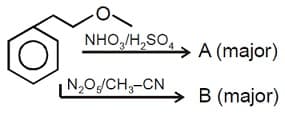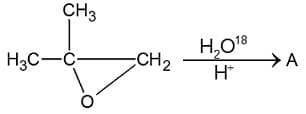Chemical Properties of Ethers
Chemical Properties of Ethers: Overview
In this topic, we shall study the cleavage of C-O bond in ethers and electrophilic substitution. We will learn about halogenation, Friedel-Crafts reaction and nitration in electrophilic substitution reaction in detail.
Important Questions on Chemical Properties of Ethers
What are the products of the following reactions?
(i)
(ii)

Anisole reacts with methyl chloride in the presence of anhydrous aluminium chloride to have methyl groups introduced at ortho and _____ position. It is an example of friedel craft's alkylation reaction.
Which of the following compound is obtained as major product on reaction of Ethoxybenzene with nitrating mixture?
Explain the following reaction of anisole.
Friedel Crafts acylation.
Explain the following reaction of anisole.
Nitration.
Explain the following reaction of anisole.
Bromination.
The product formed in the following reaction are:
Anisole on reaction with chloromethane in presence of anhydrous gives
The ether that undergoes electrophilic substitution reactions is
Dimethyl ether when heated with excess gives
In the following reaction
is
The ethereal linkage is cleaved by
In the following reaction, final product is

Ethoxy ethane with dil. gives

In products , nitro group is attached to
Epoxides (or oxiranes) are three membered cyclic ether's and differ from other cyclic and acyclic ether's in that they are reactive to various reagents. The reason for this reactivity is the strained three membered ring. Reactions with nucleophiles can result in ring opening and relief of strain. Nucleophiles will attack either of the electrophilic carbons present in an epoxide by an reaction.

A and B are

A diol with following structure having is


